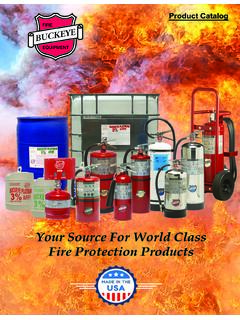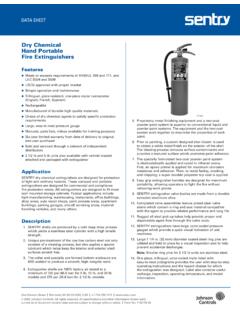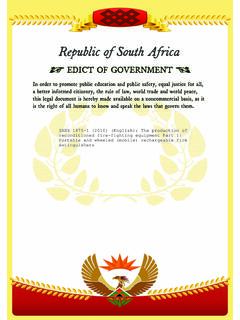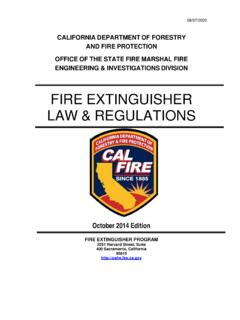Transcription of How to use a Portable Fire Extinguisher
1 How to use aPortable Fire ExtinguisherBrought to you more fire protection training materials, please Fire Equipment Manufacturers Association FIRE EQUIPMENT MANUFACTURERS ASSOCIATION, Sumner AvenueCleveland, OH 44115-2851 Tel: 216-241-7333 Fax:216-241-0105 FEMA, The Life Safety Group is an international, non-profit tradeassociation dedicated to saving livesand protecting property throughfirst line of defense fire protectionproducts and OF FIRESC lass A firesare fires inordinary combustibles such as wood, paper, cloth, trash,and B firesare fires inflammable liquids such as gasoline, petroleum oil, and paint. Also included are flammable gases such as propane and butane. Class B fires do not include fires involvingcooking oils and C firesare fires involvingenergized electrical equipmentsuch as motors, transformers,and appliances. Remove thepower and the Class C firebecomes one of the other classes of D firesare fires in combustible metals such aspotassium, sodium, aluminumand K firesare fires in cookingoils and greases such as animalfats and vegetable WOOD PAPERLIQUIDS ELECTRICAL METALSDCOOKING OILS BEFORE USING A FIRE Extinguisher , BE SURE the fire department has been called you have announced the fire to alert others occupants have begun evacuating or are leaving the structure the fire is small and not spreading you know how to operate the fire Extinguisher , and the fire won't block yourunobstructed escape routeProvided by the National Fire Protection Association (NFPA).
2 Pullthe pin. Aimthe nozzle or hose atthe base of the fire from therecommended safe distance. Squeezethe operatinglever to discharge the fireextinguishing agent. Starting at the recommendeddistance, Sweepthe nozzle orhose from side to side untilthe fire is out. Move forwardor around the fire area as thefire diminishes. Watch thearea in case of re-ignition. When it s time to use a Fire Extinguisher , just rememberPULLAIMSQUEEZESWEEPPASS!TYPES OF EXTINGUISHERSDry Chemicalfire extinguishers extinguish thefire primarily by interrupting the chemical reactionin the fire. Today s most widely used type of fire Extinguisher is the multipurpose dry chemicalthat is effective on Class A, B and C fires. This agentalso works by creating a barrier between the oxygenelement and the fuel element on Class A dry chemical is for Class B & C fires only. It is important to use the correct Extinguisher forthe type of fuel!
3 Using the incorrect agent canallow the fire to re-ignite after apparently beingextinguished and Foamfire extinguishers extinguishthe fire by taking away the heat from the agents also separate the oxygen from thefuel and heat. Water extinguishers are for Class Afires only, they should not be used on Class B or Cfires. The discharge stream could spread theflammable liquid in a Class B fire or could create ashock hazard on a Class C fire. Foam extinguisherscan be used on Class A & B fires only. They are notfor use on Class C fires due to the shock Dioxidefire extinguishers extinguishthe fire byseparating the oxygen element from thefuel and heat, and also by removing the heat witha very cold discharge. Carbon dioxide can be usedon Class B & C fires. They are usually ineffective onClass A Chemicalis a new agent that extinguishesthe fire by removing the heat from the fire andprevents re-ignition by creating a barrier betweenthe oxygen and fuel elements.
4 Wet chemical orClass K extinguishers were developed for modern,high efficiency deep fat fryers in commercial cooking operations. Some may also be used onClass A fires in commercial kitchens. Halogenated or Clean Agentextinguishersare either based on halocarbon agents or on theolder and no longer made halon 1211 agent,which can no longer be used for agents replaced halon 1211 within thelast 8 years and are much more environmentallyacceptable. Commercialized halocarbon agentsextinguish the fire by removing heat from thecombustion zone. Halon 1211 extinguishers, how-ever, were chemically active and interfered withthe chemical reactions occurring in the combustionzone. Halocarbon and halon 1211 extinguishersareeffective on Class A, B, and C type fires,although very small sizes do not achieve thelowest UL Class A rating, Powderextinguishers are similar to drychemical except that they extinguish the fire byseparating the fuel from the oxygen element ofthe fire.
5 However, dry powder extinguishers arefor Class D or combustible metal fires, only. Theyare ineffective on all other classes of Mistextinguishers are a recent develop-ment that extinguishes the fire by taking awaythe heat from the fire. They are an alternative tothe clean agent extinguishers where contaminationis a concern. Water mist extinguishers are primarilyfor Class A fires, although they are safe for use onClass C fires as








